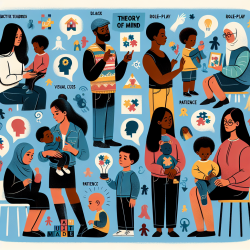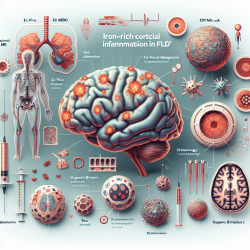As practitioners dedicated to improving the lives of children, it's essential to base our interventions on robust research findings. A recent study titled "Parental strategies to promote theory of mind development in autistic children of color" provides valuable insights into how parents can foster theory of mind (ToM) and other developmental skills in autistic children of color. This blog will explore these strategies and offer practical advice for implementation in clinical settings.
Understanding Theory of Mind (ToM)
Theory of Mind (ToM) refers to the ability to attribute mental states—such as beliefs, intents, desires, and emotions—to oneself and others. This cognitive skill is crucial for social interactions and is often impaired in children with Autism Spectrum Disorder (ASD). The study highlights how ToM development can be uniquely influenced by cultural and familial contexts, particularly in children of color.
Key Findings from the Study
The study involved four families with autistic children of color and identified several strategies parents use to foster ToM and other developmental skills. Here are some of the main findings:
- Storytelling: Parents often used storytelling to teach their children about emotions and perspectives. Acting out characters' feelings and discussing their thoughts helped children understand and relate to the narratives.
- Mimicking: Parents used mimicking as a way to teach social behaviors and emotional responses. This included making different voices for characters and asking children to mimic facial expressions and emotions.
- Social Activity: Encouraging social interactions through modeling and verbal cues was another common strategy. Parents guided their children in social settings to help them engage with peers.
- Language Development: While all the children were monolingual, parents emphasized the importance of language in developing ToM. They used verbal reinforcements and encouraged children to articulate their thoughts and feelings.
- Supportive Environment: Creating a nurturing and supportive home environment was deemed crucial. Parents emphasized warmth, affection, and positive reinforcement to help their children feel secure and understood.
Practical Applications for Practitioners
Based on these findings, here are some practical strategies that practitioners can implement:
- Incorporate Storytelling: Use social stories and role-playing activities in therapy sessions to help children understand emotions and perspectives.
- Encourage Mimicking: Use games and activities that involve mimicking facial expressions and social behaviors to reinforce learning.
- Facilitate Social Interactions: Organize group activities that encourage turn-taking and sharing interests to improve social skills.
- Language Support: Focus on language development by encouraging children to verbalize their thoughts and feelings. Use positive reinforcements to motivate them.
- Create a Supportive Environment: Advise parents to create a nurturing home environment that emphasizes warmth, affection, and positive reinforcement.
Encouraging Further Research
While this study provides valuable insights, it also highlights the need for further research, particularly in underrepresented communities. Practitioners are encouraged to engage in or support research that explores the unique experiences of autistic children of color and their families.
To read the original research paper, please follow this link: Parental strategies to promote theory of mind development in autistic children of color.










